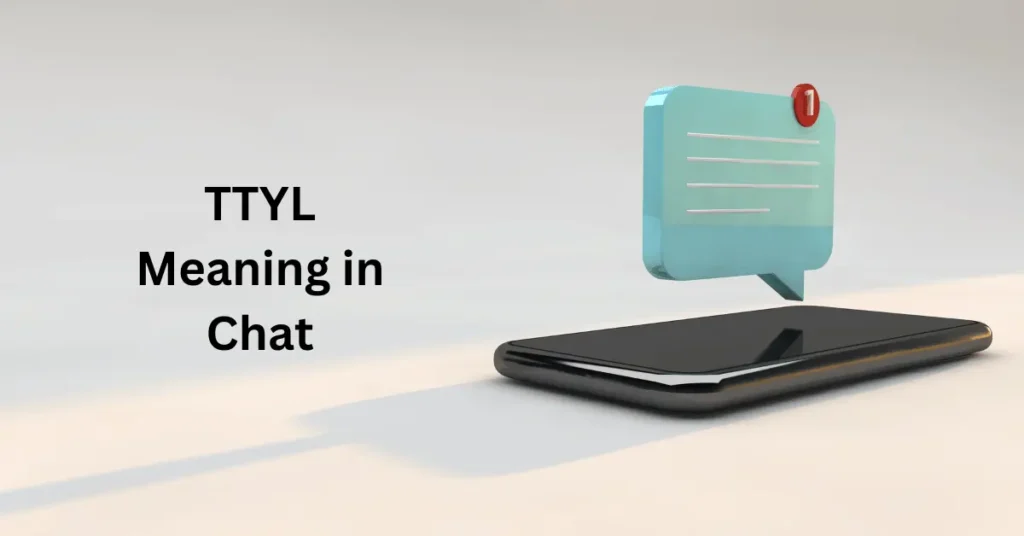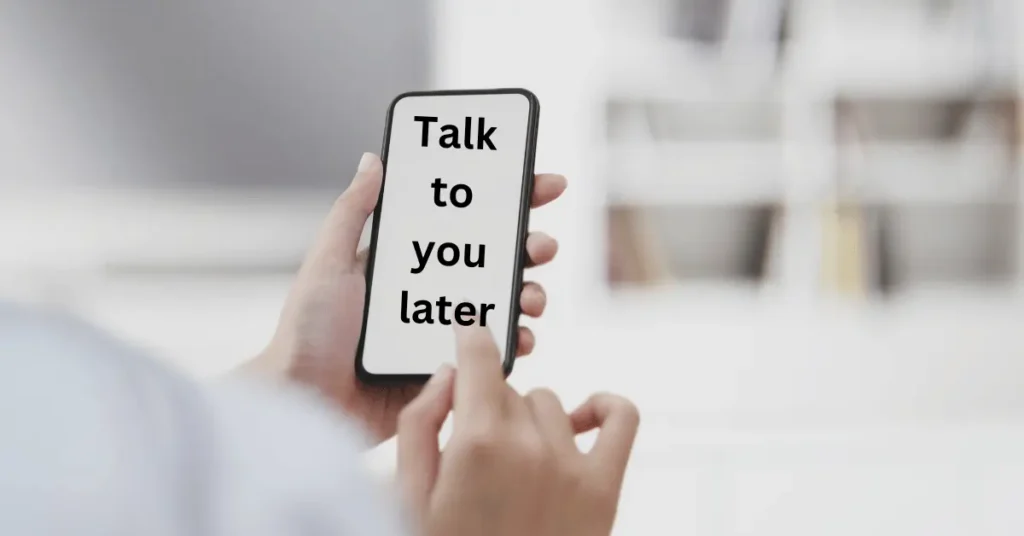TTYL Meaning in Chat

In today’s fast-paced digital world, we often rely on abbreviations to keep our conversations short and sweet. Learna bout TTYL meaning in chat.
One of the most common acronyms you’ll see in text messages and chats is “TTYL.”
If you’ve ever wondered what “TTYL” means or why it’s so widely used, you’re not alone!
In this post, we’ll dive into the meaning of “TTYL,” explore its history, and explain why it’s become such a popular way to say goodbye online.
So, let’s chat about “TTYL meaning in chat” and uncover the story behind this handy shortcut!
What Does “TTYL” Mean?
TTYL is an abbreviation for the phrase Talk to you later.
It’s commonly used in text messages, online chats, and social media conversations as a way to say goodbye or sign off without implying that the conversation is over forever.
Instead, it suggests that the person plans to continue the conversation at a later time, making it a casual, friendly way to end a chat.
Unlike a more formal “goodbye,” which can signal the end of a conversation, “TTYL” leaves the door open for future communication.
It’s often used between friends, family, or acquaintances, especially in informal settings where the tone is lighthearted and the goal is simply to acknowledge that you’ll talk again soon.
For example, you might say “TTYL” at the end of a conversation when you’re heading off to do something else but want to leave the interaction open for future chats. It’s a way of saying, “I’ll talk to you again later, but I need to go for now.”
“TTYL” is widely recognized and used in both texting and on social media platforms like Instagram, Facebook, and Twitter, where quick and casual communication is the norm. It’s just one of the many digital shortcuts that help people stay connected while keeping things brief and easy.
Definition of “TTYL” Meaning in Chat
Definition: “TTYL” stands for “Talk to you later.” It’s a casual, shorthand way of saying goodbye in online chats, text messages, and even social media interactions.
When you use “TTYL,” you’re essentially letting the other person know that you’re leaving the conversation but that you intend to speak to them again in the future.
It’s a polite, friendly, and non-final way of ending a chat, implying that the conversation is only paused temporarily.
“TTYL” is typically used when you’re signing off from a conversation, but unlike saying “goodbye,” it doesn’t carry the weight of finality.
It’s lighthearted, making it clear that the conversation isn’t over for good, just for now.
Examples of “TTYL” in Chat:
Example 1
Friend 1: “I have to run, but I’ll message you later about the plans for the weekend!”
Friend 2: “Sounds good! TTYL!”
(Here, Friend 2 uses “TTYL” to casually end the conversation but indicates they’ll continue the chat later.)
Example 2
Mom: “Dinner’s ready! Come to the kitchen.”
You: “Okay, I’ll be there in a sec. TTYL!”
(In this case, “TTYL” is used to wrap up the chat quickly as you need to go do something else, but you’ll talk again soon.)
Example 3
Friend 1: “I’ll call you after my meeting to talk more about the project.”
Friend 2: “Great! TTYL!”
(Friend 2 uses “TTYL” as a way to sign off while indicating the conversation will continue after the meeting.)
Example 4
You: “I gotta go, my class is starting. TTYL!”
Friend: “Alright, have a good class! TTYL!”
(Here, both friends use “TTYL” to end the chat temporarily while expressing a friendly, casual sign-off.)
Why People Use “TTYL” “TTYL” is preferred over just saying “goodbye” because it feels less formal and more relaxed.
It gives the impression that the conversation is only taking a break, rather than ending for good.
This makes it ideal for casual conversations where both people are likely to talk again soon, and it helps maintain a positive, ongoing tone in the relationship.
Word Origin of “TTYL” in Chat

The origin of “TTYL” can be traced back to the early days of internet communication in the late 1990s and early 2000s.
As the internet became more accessible, people started using instant messaging platforms like AOL Instant Messenger (AIM), ICQ, and MSN Messenger.
These platforms allowed users to engage in real-time conversations, and the demand for quick, efficient communication grew.
The Rise of Acronyms and Abbreviations
As people spent more time online chatting with friends and family, they began to shorten their messages to save time and typing effort.
With the limited character count on some early platforms, shorthand became a necessity. This led to the rise of acronyms like “LOL” (laugh out loud), “BRB” (be right back), and “GTG” (got to go).
“TTYL” was part of this wave of shorthand abbreviations. It emerged around the same time as other chat acronyms, primarily within the world of text-based communication.
The phrase “Talk to you later” is naturally a common farewell expression, so it was only a matter of time before it was shortened to “TTYL” for quick and easy use.
AOL Instant Messenger and Early Chat Rooms
The first major platforms where “TTYL” gained popularity were the chatrooms and instant messaging services like AIM.
These services, which became a central part of online socializing, made it easy for people to send quick, informal messages.
As users became accustomed to using abbreviations to streamline their conversations, “TTYL” began to spread. It quickly caught on, especially among younger generations who were fluent in the language of the internet.
Cultural Influence and Mainstream Adoption
While “TTYL” started in chat rooms, it didn’t stay confined to them for long. The phrase soon made its way into text messaging, where character limits were again a factor, and users wanted to communicate as efficiently as possible.
Over the years, the abbreviation also infiltrated social media platforms like Facebook, Twitter, and later Instagram, where brevity and informality were key.
By the mid-2000s, “TTYL” had become so ingrained in internet culture that it began to appear in mainstream media.
TV shows, movies, and even music began to reference internet lingo, and “TTYL” became a widely recognized and accepted part of casual conversation.
In fact, “TTYL” became so popular that it even made its way into formal writing, appearing in books and online content.
Evolution and Use Today
Today, “TTYL” continues to be a staple of online communication. Its usage has expanded beyond text and chat platforms, making appearances in emails, on social media, and even in real-world conversations among younger people familiar with internet culture.
While newer abbreviations like “BRB” or “LOL” may come and go, “TTYL” remains a timeless and widely recognized phrase used to say “goodbye” while signaling that the conversation will pick up again later.
FAQs
What does TTYL stand for?
TTYL stands for “Talk to you later.” It’s a casual abbreviation used to say goodbye in an online chat or text message, suggesting that the conversation is just taking a break and will continue later.
When should I use TTYL?
You should use TTYL when you’re wrapping up a conversation in a friendly and informal way. It’s best used with friends, family, or anyone you’re having a casual conversation with. It signals that the chat isn’t over forever but will resume at a later time.
Is TTYL still used today?
Yes, TTYL is still widely used today, especially in casual conversations. While newer acronyms and emojis have become popular, TTYL remains a go-to phrase for saying goodbye in chats, texts, and even on social media.
Can I use TTYL in formal conversations?
No, TTYL is considered informal and should not be used in professional or formal settings. It’s best reserved for conversations with friends, family, or others you communicate casually with.
Are there any other ways to say “Talk to you later”?
Yes, there are several other ways to say “Talk to you later” in an informal chat. Some alternatives include “BRB” (be right back), “Catch you later,” “TTFN” (ta-ta for now), or simply “See you later.” Each of these can be used depending on the tone or closeness of the conversation.
Conclusion
In the world of digital communication, “TTYL” has become a simple and friendly way to say goodbye.
It stands for “Talk to you later,” and it’s commonly used in casual chats and texts to signal that the conversation isn’t over, just paused for now.
Whether you’re texting a friend or chatting online, “TTYL” is a quick, lighthearted way to wrap things up while keeping the door open for future conversations.
So, the next time you’re ready to sign off, just say “TTYL,” and know you’ll be chatting again soon!
Extra Points
- A Part of Internet Culture: “TTYL” isn’t just an abbreviation—it’s a part of internet culture. It’s a quick, friendly way to keep conversations informal and relaxed. Over time, it has become one of the most recognized chat terms across the world.
- Helps Save Time: Using shorthand like “TTYL” helps save time, especially when you need to wrap up a conversation quickly. It’s a perfect solution when you’re busy but want to end the chat politely without feeling rushed.
- Widely Used by Different Age Groups: While “TTYL” is especially popular with younger generations, it’s used by people of all ages. It has crossed generational lines and is now part of everyday communication for anyone familiar with texting or chatting online.
- Works Across Platforms: Whether you’re texting on your phone, chatting on social media, or messaging on instant platforms like WhatsApp or Facebook, “TTYL” works everywhere. It’s an easy way to sign off in any type of digital conversation.
- A Symbol of Online Friendliness: “TTYL” represents the laid-back, friendly nature of online communication. It’s not a formal goodbye, but a warm, open-ended one—showing that even though you’re signing off, the connection remains.